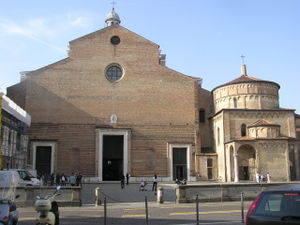
Padua Cathedral
Encyclopedia

Minor basilica
Minor basilica is a title given to some Roman Catholic churches. By canon law no Catholic church can be honoured with the title of basilica unless by apostolic grant or from immemorial custom....
in Padua
Padua
Padua is a city and comune in the Veneto, northern Italy. It is the capital of the province of Padua and the economic and communications hub of the area. Padua's population is 212,500 . The city is sometimes included, with Venice and Treviso, in the Padua-Treviso-Venice Metropolitan Area, having...
, northern Italy
Italy
Italy , officially the Italian Republic languages]] under the European Charter for Regional or Minority Languages. In each of these, Italy's official name is as follows:;;;;;;;;), is a unitary parliamentary republic in South-Central Europe. To the north it borders France, Switzerland, Austria and...
. The cathedral is the see
Episcopal See
An episcopal see is, in the original sense, the official seat of a bishop. This seat, which is also referred to as the bishop's cathedra, is placed in the bishop's principal church, which is therefore called the bishop's cathedral...
of the Diocese of Padua
Roman Catholic Diocese of Padua
The Roman Catholic Diocese of Padua is a see of the Catholic Church in the Veneto, northern Italy. It was erected in the 3rd century, and is a suffragan of the Patriarchate of Venice. The current Bishop of Padova is Antonio Mattiazzo....
, and is dedicated to to the Assumption
Assumption of Mary
According to the belief of Christians of the Roman Catholic Church, Eastern Orthodoxy, Oriental Orthodoxy, and parts of the Anglican Communion and Continuing Anglicanism, the Assumption of Mary was the bodily taking up of the Virgin Mary into Heaven at the end of her life...
of the Blessed Virgin Mary.
It is the third edifice built on the same site. The first one was erected after the Edict of Milan
Edict of Milan
The Edict of Milan was a letter signed by emperors Constantine I and Licinius that proclaimed religious toleration in the Roman Empire...
in 313 and destroyed by an earthquake on the 3 January 1117. It was rebuilt in Romanesque
Romanesque architecture
Romanesque architecture is an architectural style of Medieval Europe characterised by semi-circular arches. There is no consensus for the beginning date of the Romanesque architecture, with proposals ranging from the 6th to the 10th century. It developed in the 12th century into the Gothic style,...
style: the appearance of the medieval church can be seen in the frescoes by Giusto de' Menabuoi
Giusto de' Menabuoi
Giusto de' Menabuoi was an Italian painter of the early Renaissance. He was born in Florence.In Lombardy he executed a fresco of the Last Judgement in the Abbey of Viboldone, Milan...
in the annexed Baptistery.
The design of the existing cathedral is sometimes attributed to Michelangelo
Michelangelo
Michelangelo di Lodovico Buonarroti Simoni , commonly known as Michelangelo, was an Italian Renaissance painter, sculptor, architect, poet, and engineer who exerted an unparalleled influence on the development of Western art...
, but in fact it was the work of Andrea della Valle
Andrea della Valle
Cardinal Andrea della Valle was an Italian clergyman and art collector.Of an ancient family of Roman nobles whose family tomb is in Santa Maria in Aracoeli, he was elected bishop of Crotone in 1496. In 1503-05 he directed the Apostolic Chancery, and served as Apostolic secretary during the...
and Agostino Righetto, with much in common with earlier Paduan churches. Although construction work began on the new Renaissance edifice
Renaissance architecture
Renaissance architecture is the architecture of the period between the early 15th and early 17th centuries in different regions of Europe, demonstrating a conscious revival and development of certain elements of ancient Greek and Roman thought and material culture. Stylistically, Renaissance...
in 1551, it was only completed in 1754, leaving the façade unfinished.

